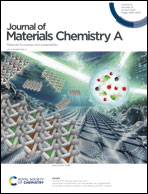Enhanced iodine capture by the hydrogen bond reconstruction strategy†
Abstract
Radioactive iodine, existing in the resulting nuclear waste, represents a potential hazard to the environment and human beings. Therefore, efficient disposal methods for radioiodine are needed. Curcumin-based ionic liquids (CILs) could break the intramolecular hydrogen bond and form an intermolecular hydrogen-bonding interaction between cations and anions, making it easier to interact with molecules such as water. Hence, we prepared two types of CILs ([Emim][Cur] and [Bmim][Cur]), that could capture iodine. The capacities of [Emim][Cur] and [Bmim][Cur] are as high as 5.13 g g−1 and 5.14 g g−1, respectively, and the iodine amount in cyclohexane is up to 1463 mg g−1 and 1395 mg g−1 corresponding to [Emim][Cur] and [Bmim][Cur] after iodine capture for 12 hours. The presence of carbonyl, ether, and phenol hydroxyl groups induces charge transfer which leads to the formation of polyiodide anions, as revealed by FT-IR, Raman, and XPS spectra. The density functional theory (DFT) analysis further confirms that the high iodine capture capacity of [Emim][Cur] and [Bmim][Cur] stems from hydrogen bond reconstruction and the strong halogen bond between iodine and keto oxygen.

- This article is part of the themed collection: 2024 Journal of Materials Chemistry A HOT Papers


 Please wait while we load your content...
Please wait while we load your content...